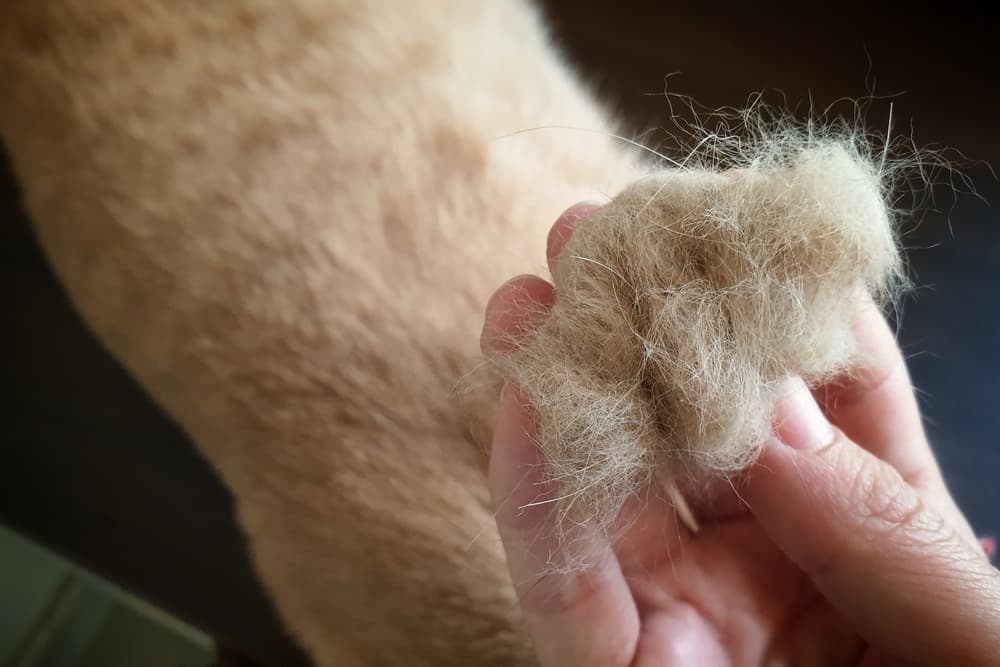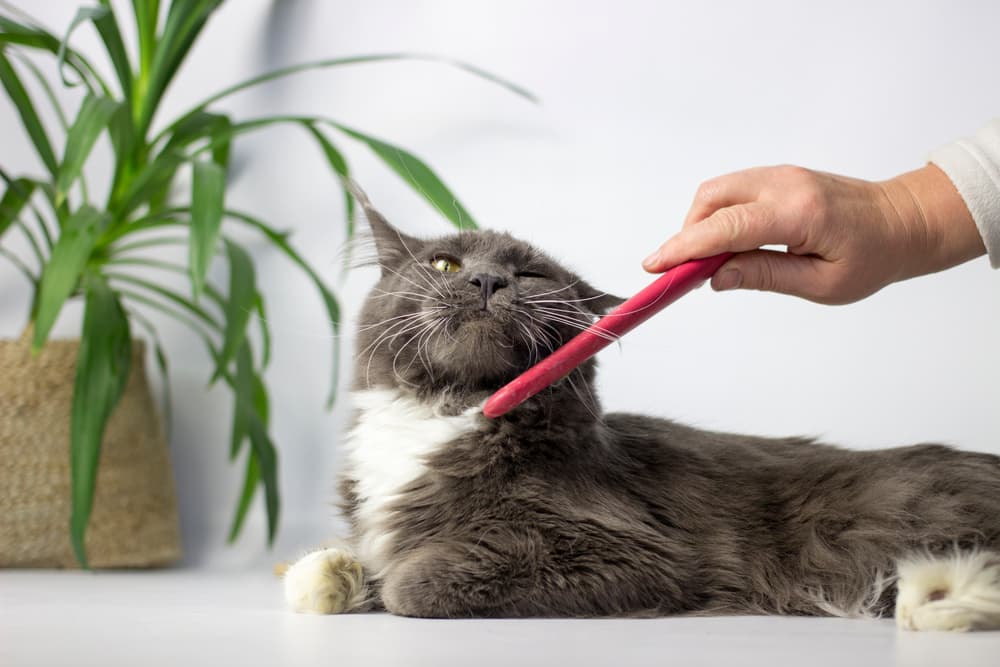If cleanliness is subsequent to godliness, it’s no marvel why cats, being the meticulous groomers they’re, require us people to worship them because the little furry gods they consider themselves to be. Nonetheless, a cat’s cleanliness and fussy grooming conduct can have one disagreeable consequence: hairballs.
Scientifically-named trichobezoars, feline hairballs are disagreeable, upchucked packages from our kitty overlords that we now have to wash off our carpet (enjoyable truth: canines can often have hairball points, too!). Whereas hairballs are widespread, they might be an indication of an underlying well being concern in your cat and might pose issues.
What Does a Cat Hairball Look Like?

Most cat hairballs are tubular-shaped, nonetheless, some might look extra like smaller, rounded or formless clumps of matted hair or perhaps a few stray hairs in a little bit of liquid. Hairballs look a bit moist and slimy or frothy as a result of saliva or gastrointestinal contents that coat them. These GI contents might tint the hairballs a yellow or darkish brown hue and might typically trigger them to be confused with stool or common vomit, though they’re not as smelly. Hairballs might vary in measurement from dime-sized to finger-length.
Opposite to well-liked perception, cats don’t cough up hairballs. Hairballs are vomited, not expelled by coughing. Some pet homeowners might confuse a real cough with an try and throw up a hairball. In case your cat is making a “hacking” noise, however no hairball is developing, your cat could also be coughing, which generally is a signal of a respiratory concern and requires a vet examination.
When your cat is about to expel a hairball, she or he might vocalize simply earlier than vomiting, decrease the pinnacle and physique with the neck outstretched, gag or retch, and should swallow a number of occasions after eliminating the hairball. Remember the fact that in the event you’re not seeing precise hairballs in your cat’s vomit, one other well being situation inflicting vomiting could also be at play, requiring a vet go to to analyze and deal with the set off on your cat’s vomiting.
What Causes Hairballs in Cats?

Grownup cats can spend as much as 25 % of their time bathing themselves. A cat’s tough tongue, with its backward-facing barbs (papillae) that “comb” by his or her hair whereas licking, picks up dust, bugs and different particles that has collected on the fur and pores and skin, together with free hair. Hair and particles are swallowed, and hair is basically indigestible, so a hairball can develop within the abdomen over time as a result of a cat’s innate grooming conduct. When the fur clump begins to annoy the liner of your cat’s abdomen, vomiting is triggered to expel it.
Early domesticated cats didn’t have as a lot hair to groom, and although their coats might have advanced, their digestive tracts haven’t modified all that a lot. Due to this fact, whereas most short-haired cats deal with hairballs fairly properly, long-haired cats might have extra issues as a result of elevated quantity of fur they inadvertently swallow upon grooming. These cats usually tend to have vomiting points related to their hairballs and are additionally at elevated threat of creating intestinal obstruction.
Lengthy-haired breeds that will wrestle extra with hairballs embrace Persians, Himalayans, Ragdolls, Maine Coons, Norwegian Forest Cats, Siberians, Turkish Angoras and Home Lengthy Hairs.
Happily, kittens are much less more likely to develop hairballs as a result of younger cats haven’t fairly realized to wash their coats as totally as their grownup counterparts, so hairballs are much less generally a priority for them.
Are Cat Hairballs Regular?

Whereas widespread, cats vomiting up a hairball is just not medically regular. In a wholesome cat, the fur that’s swallowed throughout grooming ought to be capable of move by the intestines and exit with the stool throughout a standard bowel motion.
Whereas a cat’s regular grooming conduct causes the event of a hairball, the way in which she or he eliminates the hair is probably not regular. In case your cat is definitely vomiting up a hairball solely as soon as per week or much less, a vet go to is probably going not wanted.
Nonetheless, in case your cat is vomiting up hairballs extra continuously (a number of occasions per week or day by day), a visit to the vet is very suggested since an underlying gastrointestinal dysfunction could also be in charge. Different components may also improve your cat’s threat of vomiting up furballs.
As mentioned, long-haired cats are predisposed to hairballs and are at the least twice as doubtless as short-haired breeds to vomit a hairball as a result of larger quantity of hair they swallow throughout grooming.

Overgrooming or compulsive grooming conduct may also improve the chance {that a} cat can have hairball points. Overgrooming could be instigated by stress or anxiousness (together with fretting over a unclean litter field), ache (a cat might obsessively lick a painful area of the physique), hair mats, pores and skin illness (reminiscent of allergy symptoms), or ectoparasites (reminiscent of fleas).
Moreover, sure digestive problems may also result in extra hairballs. Gastrointestinal motility problems (when the GI tract doesn’t contract in a ahead movement the way in which it ought to, permitting fur to build up and tangle up within the abdomen) and underlying causes of persistent vomiting (reminiscent of inflammatory bowel illness or GI lymphoma) can all improve the danger of hairball issues.
Hairballs are usually not sometimes very harmful, however they will lodge within the esophagus (posing harm), or develop giant sufficient to trigger a life-threatening intestinal obstruction (or blockage), which requires quick medical intervention.
Indicators that will point out a major problem that requires medical help embrace:
- Frequent vomiting or makes an attempt to vomit with out output
- Decreased urge for food
- Lethargy
- Hiding conduct
- A bloated or painful stomach
- Constipation or irregular fecal output
Hairball Remedies for Cats

As mentioned, in case your cat is simply producing a hairball often, veterinary intervention is just not often essential. Nonetheless, schedule an appointment for a vet check-up in case your cat has extra frequent hairballs. At all times search veterinary care in case your cat seems as if she or he is making an attempt to expel a hairball however can’t.
Happily, most hairballs can move with out concern and could be extra simply managed with sure treatments and industrial remedies. Nonetheless, many dwelling treatments can do extra hurt than good and are usually not suggested.
Cat Hairball Treatment

One at-home treatment which may be useful is utilizing a small quantity of plain petroleum jelly. A one-quarter teaspoon could be positioned in your cat’s paw for her or him to lick off and swallow. This routine could also be repeated as much as a few times per week.
The petroleum jelly acts as a lubricant to assist the passage of hair by the intestines and into feces. Due to this fact, when used sparingly, a tiny quantity of petroleum jelly or comparable gel-based hairball therapy marketed for cats can scale back hairballs from being expelled the mistaken means.
Some moist wipes or shampoos are additionally marketed to cut back shedding, thereby decreasing hairball formation, but many are ineffective. Using hypoallergenic grooming wipes might at the least assist take away lifeless or free hair earlier than it’s swallowed, but frequently brushing your cat is simpler.
Cat Hairballs: House Treatments to Keep away from

Butter and oils (reminiscent of olive oil, coconut oil, and fish oil) could also be ample lubricants to assist hair slide extra simply by the intestines. Nonetheless, an excessive amount of of those fat may cause GI upset (together with diarrhea and vomiting), pancreatitis or weight acquire. Due to this fact, cat mother and father ought to keep away from feeding them to their cats until directed by a veterinarian.
Elevated fiber can assist pace up transit time by the GI tract, growing the chances that swallowed hair makes its means out into the litter field in your cat’s stool slightly than upchucked in vomit in your rug. Nonetheless, improper quantities of fiber dietary supplements (reminiscent of Metamucil powder) may cause painful gasoline distension and GI upset. Moreover, canned pumpkin is unlikely to include sufficient fiber to be useful. For those who’re trying to improve fiber in your cat’s food plan, take into account cat grass or a industrial food plan specifically formulated for hairball management (particulars beneath) after talking together with your veterinarian.
Hairball Drugs for Cats

Different industrial merchandise, both over-the-counter or prescription hairball merchandise, may also assist ease the passage of hairballs. Earlier than making an attempt any medicine, a fast chat or go to together with your vet is advisable to make sure that there aren’t any underlying points inflicting your cat to have hairball points. If different components are recognized, these must be handled first.
Laxatone, a light laxative and lubricant, is a mainstay oral medicine in managing feline hairballs. Formulations embrace both unflavored or flavored gels or powders which may be given instantly by mouth or else positioned in your cat’s meals. Chew treats are additionally obtainable. Whereas usually secure and gentle when used as directed, an excessive amount of laxatone may cause diarrhea. Ask your vet for recommendation prior to make use of.
Following a full workup by your veterinarian to make sure that no different well being points are contributing to your cat’s battle with hairballs, a medicine known as metoclopramide could be prescribed to assist hairballs transfer within the appropriate route and never again up by the mouth.
Stopping Hairballs in Cats

You possibly can lower your cat’s possibilities of creating hairballs with common grooming and brushing (to take away free fur earlier than your cat has an opportunity to ingest it). It’s possible you’ll have to steadily get your cat used to being brushed through the use of optimistic reinforcement, however most cats benefit from the TLC. Deshedding brushes are particularly useful, as they gently take away free hairs within the high coat of a cat’s fur and the denser undercoat.
Lengthy-haired breeds ought to ideally be brushed day by day. Eradicating fur clumps and hair mats earlier than your cat has an opportunity to swallow a giant wad of fur can also be significantly useful. Clipping or shaving your long-haired cat could also be essential; you might want to search help from an expert pet groomer.
Moreover, ask your vet a few feline food plan formulated to assist scale back hairball growth. Hairball-control cat meals comprises elevated fiber and comprises fatty acids and different vitamins to enhance your cat’s coat and scale back shedding.
Feeding smaller quantities of meals extra continuously may also assist preserve hairballs at bay. Most moist meals are additionally useful to feed, as canned meals comprises a better moisture content material to assist transfer furballs by the intestines. Pet mother and father may also encourage elevated water consumption by guaranteeing that water bowls are at all times clear and full or utilizing a fountain or bubbler, which many cats get pleasure from. Be cautious of treats marketed as hairball treatments, as many are stuffed with empty energy and should not at all times assist with hairball points.
Moreover, scale back the danger of overgrooming to forestall your cat from swallowing any extra hair than essential. You possibly can scale back the dangers of overgrooming by:
- Retaining all litter bins clear
- Offering your cat with environmental enrichment
- Using cat pheromones to cut back stress
- Managing any persistent ache with steering out of your vet
- Utilizing year-round prescription flea preventives
- Managing any pores and skin illnesses your cat might have as directed by your vet
These prevention methods can assist scale back the severity of your cat’s hairball drawback. Nonetheless, in case your cat remains to be struggling, discuss together with your vet.
